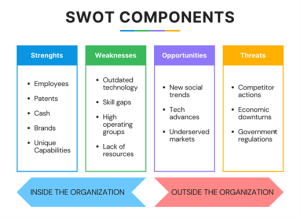7.3. The SWOT analysis
You may already be familiar with a common tool used to analyze strategic and competitive situations: SWOT analysis. SWOT stands for Strengths, Weaknesses, Opportunities and Threats. This tool helps nutrition professionals understand their organization’s internal capabilities and external challenges, providing a clear view of their strategic position. Let’s break down SWOT analysis piece by piece (Figure 7.1) (Bright et al., 2019; Reynolds & Mcclusky, 2013)

Fig 7.1. SWOT Analysis
Strengths
Strengths are the internal attributes and resources that an organization excels in. For instance, a nutrition organization’s strengths might include a highly skilled team of dietitians, advanced nutritional assessment tools, or strong community relationships. Identifying these strengths allows the organization to leverage them to achieve its goals. For example, if a nutrition clinic has expertise in managing diabetes, it can plan to expand its services to include more specialized diabetes care programs, utilizing its strong reputation and experience in this area.
Weaknesses
Weaknesses are internal factors that limit an organization’s effectiveness or capabilities. These are areas where the organization may lack resources or skills. For example, a nutrition organization might struggle with outdated technology or limited funding for new programs. Understanding these weaknesses helps the organization avoid areas where it may be less effective or seek improvements. For instance, if a clinic has limited resources for conducting advanced research, it might collaborate with academic institutions or seek grants to bolster its research capabilities.
Opportunities
Opportunities are external factors that the organization can potentially capitalize on. These are emerging trends or situations in the market that align with the organization’s strengths. For example, increasing public interest in personalized nutrition could present an opportunity for a nutrition organization to develop customized diet plans or innovative wellness programs. Recognizing opportunities enables the organization to expand its services or enter new markets. However, it’s crucial to ensure that the organization is equipped to seize these opportunities effectively.
Threats
Threats are external challenges that could negatively impact the organization’s success. These might include changes in regulations, increased competition, or shifts in public health trends. For instance, new legislation that impacts the way nutrition services are delivered could pose a threat. By identifying these threats, an organization can develop strategies to mitigate their impact. For example, if new regulations affect service delivery, the organization might adapt by updating its practices or engaging in advocacy to address the changes.
The Limitations of SWOT Analysis
While SWOT analysis is a valuable tool for identifying internal and external factors, it has its limitations. The effectiveness of SWOT depends on the depth of the analysis and the accuracy of the information considered. It may not capture all potential issues or nuances, making it essential to complement SWOT with other strategic analysis tools for a more comprehensive evaluation. This chapter will explore additional methods to develop a more thorough and systematic strategic analysis, enhancing the ability to address both internal and external factors impacting nutrition organizations.
Media Attributions
- Picture2

